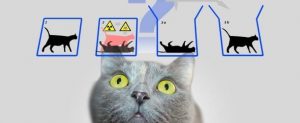Quantum News Briefs May 3: European space giants join forces for “Infrastructure for Resilience, Interconnectivity and Security by Satellite” (IRIS²) that uses quantum cryptography; Envisioning a quantum leap with 5G networks for the future of telecom; Heaviest ‘Schrödinger Cat’ ever created at ETH Zurich + MORE

Quantum News Briefs May 3: European space giants join forces for “Infrastructure for Resilience, Interconnectivity and Security by Satellite” (IRIS²) that uses quantum cryptography; Envisioning a quantum leap with 5G networks for the future of telecom; Heaviest ‘Schrödinger Cat’ ever created at ETH Zurich + MORE.
European space giants join forces for “Infrastructure for Resilience, Interconnectivity and Security by Satellite” (IRIS²) that uses quantum cryptography
 Europe’s largest space companies have banded together to bid for a role in the European Union’s proposed multi-orbit connectivity constellation. The group is led by satellite operators Eutelsat, SES, and Hispasat; and satellite makers Airbus Defence and Space and Thales Alenia Space.
Europe’s largest space companies have banded together to bid for a role in the European Union’s proposed multi-orbit connectivity constellation. The group is led by satellite operators Eutelsat, SES, and Hispasat; and satellite makers Airbus Defence and Space and Thales Alenia Space.
Satellite operator Hisdesat, spaceflight services company Telespazio, aerospace giant Thales, small satellite manufacturing specialist OHB, and terrestrial telcos Deutsche Telekom and Orange are also part of the group.
Europe issued a request for competing bids in March to develop IRIS², or Infrastructure for Resilience, Interconnectivity and Security by Satellite, after approving plans to fund half the 6 billion euro ($6.6 billion) project. IRIS², which would complement satellites Europe has in geostationary orbit (GEO) and use quantum cryptography to protect communications, comes amid the growing dominance of U.S.-based Starlink’s broadband network in low Earth orbit (LEO) — and Chinese plans for a rival megaconstellation.
The newly created consortium of established space firms said their integrated team would seek to foster collaboration among all European space players. Commercial companies are expected to cover the rest of the cost for a constellation projected to provide global coverage by 2027.
Under measures designed to encourage smaller businesses to participate in IRIS², successful bidders must subcontract out at least 30% of contracts above 10 million euros via a competitive tender process.
The companies leading the consortium were part of an earlier study group the European Commission chose in 2020 to explore the feasibility of a sovereign constellation, which also included launch services provider Arianespace.
The competitive tender for IRIS² is open to companies bidding collectively, and initial proposals are due this summer. Click here to read May 2 announcement published in SpaceNews.
Envisioning a quantum leap with 5G networks for the future of telecom
 Quantum technologies have the potential to revolutionize 5G networks by enhancing security, increasing network capacity, and reducing latency. Some of the applications of quantum technologies in 5G include quantum key distribution, quantum cryptography, and quantum sensing. Quantum News Briefs summarizes recent article from Network Express.
Quantum technologies have the potential to revolutionize 5G networks by enhancing security, increasing network capacity, and reducing latency. Some of the applications of quantum technologies in 5G include quantum key distribution, quantum cryptography, and quantum sensing. Quantum News Briefs summarizes recent article from Network Express.
There are several examples of the use of quantum technologies in 5G networks, although commercial deployment of these technologies is still in the early stages. Here are some examples:
1. In 2020, China Mobile partnered with QuantumCTek to deploy a 5G network that uses quantum cryptography to provide secure communication between two government agencies in Shanghai. The network uses QKD technology to encrypt data transmitted between the agencies, ensuring the security of the communication.
2. In 2021, SK Telecom, a South Korean telecommunications company, partnered with ID Quantique to deploy a 5G network that uses quantum cryptography to secure critical communication between its headquarters and data center. The network uses QKD technology to provide unbreakable encryption for data transmission.
As for factual figures, it is worth noting that quantum technologies are still in the early stages of commercial deployment in 5G networks, and it is difficult to provide exact numbers. However, it is estimated that the global market for quantum cryptography could reach $2.2 billion by 2026, driven by the growing demand for secure communication in 5G networks and other industries. Additionally, according to a report by ResearchAndMarkets, the market for quantum sensors is expected to grow from $278 million in 2020 to $1.1 billion by 2025, driven by the increasing adoption of quantum technologies in various applications, including 5G networks.
India has also been actively exploring the use of quantum technologies in various industries, including telecommunications. The Indian government announced the establishment of the Quantum Communication Application and Technology (Q-CAT) lab in Delhi, which is a joint initiative of the Department of Telecommunications (DoT) and the Indian Institute of Technology (IIT) Delhi. The lab is expected to develop indigenous technologies for secure communication, including QKD for 5G networks. Click here to read NetworkExpress article in-entirety.
Heaviest ‘Schrödinger Cat’ ever created at ETH Zurich
 Physicists at the Swiss Federal Institute of Technology (ETH) Zurich coupled a mechanical resonator to a type of superconducting circuit commonly used in quantum computing to effectively replicate Erwin Schrödinger’s famous thought experiment on an unprecedented scale. Quantum News Briefs summarizes recent update.
Physicists at the Swiss Federal Institute of Technology (ETH) Zurich coupled a mechanical resonator to a type of superconducting circuit commonly used in quantum computing to effectively replicate Erwin Schrödinger’s famous thought experiment on an unprecedented scale. Quantum News Briefs summarizes recent update.
A tiny vibrating crystal weighing little more than a grain of sand has become the heaviest object ever to be recorded in a superposition of locations.
Ironically, Schrödinger would be somewhat skeptical that anything so large – well, anything at all – could exist in a nebulous state of reality.
Nearly a century on, Schrödinger’s cat is no longer a joke. It’s been observed not only in tiny particles but in entire molecules (not to mention in clusters of thousands of atoms). We can manipulate the box to ensure the cat never dies. We can even tinker with the setup to pull the cat apart. In fact, entire technologies are founded on the very principles of objects in states of superposition.
In this latest experiment, a high-overtone bulk acoustic-wave resonator, or HBAR, served as a 16.2 microgram cat. What it lacked in whiskers and fish breath, it made up for in the fact it could hum across a short range of frequencies when powered by a current.
“By putting the two oscillation states of the crystal in a superposition, we have effectively created a Schrödinger cat weighing 16 micrograms,” says senior author and ETH Zurich physicist Yiwen Chu. Click here to read complete article by Mike McRae on Science News.
AI Startup Eternal Mind to bring quantum research center to former Loring Air Force Base
Eternal Mind, an artificial intelligence startup company in Kennebunk Maine, will begin renovations for a first quantum computing research center at the former Loring Air Force Base.
Founded in 2021, Eternal Mind is the first company that Green 4 Maine, which owns part of the former base, has recruited to help revitalize Loring as an aerospace and technology hub. The base closed in 1994, with 3,800 of its 9,000 acres becoming the Loring Commerce Centre, operated by Loring Development Authority.
Earlier this year, Maine-based development corporation Green 4 Maine purchased 450 acres from Loring Development Authority. They promised to create new housing and bring hundreds of jobs to the region within the next decade. Before coming to Aroostook County, the group had worked on manufacturing development in southern Maine.
With a team of highly skilled engineers and data scientists, Eternal Mind is focused on creating solutions that make AI technology accessible to everyone. Eternal Mind is committed to helping businesses, organizations, and individuals take advantage of the power of AI to automate processes, improve decision-making, and enhance customer experiences.
From predictive analytics to natural language processing, Eternal Mind is continuously innovating and developing solutions that make AI solutions more accessible, affordable, and effective.
Earlier this year, Maine-based development corporation Green 4 Maine purchased 450 acres from Loring Development Authority. Eternal Mind hopes to create at least 30 to 50 new jobs at Loring and open its research center by the end of this year. If they succeed, Green 4 Maine will be on its way to fulfilling a major promise for Loring. The corporation must create at least 75 new jobs before acquiring more Loring land, per its agreement with Loring Development Authority.
Sandra K. Helsel, Ph.D. has been researching and reporting on frontier technologies since 1990. She has her Ph.D. from the University of Arizona.



















